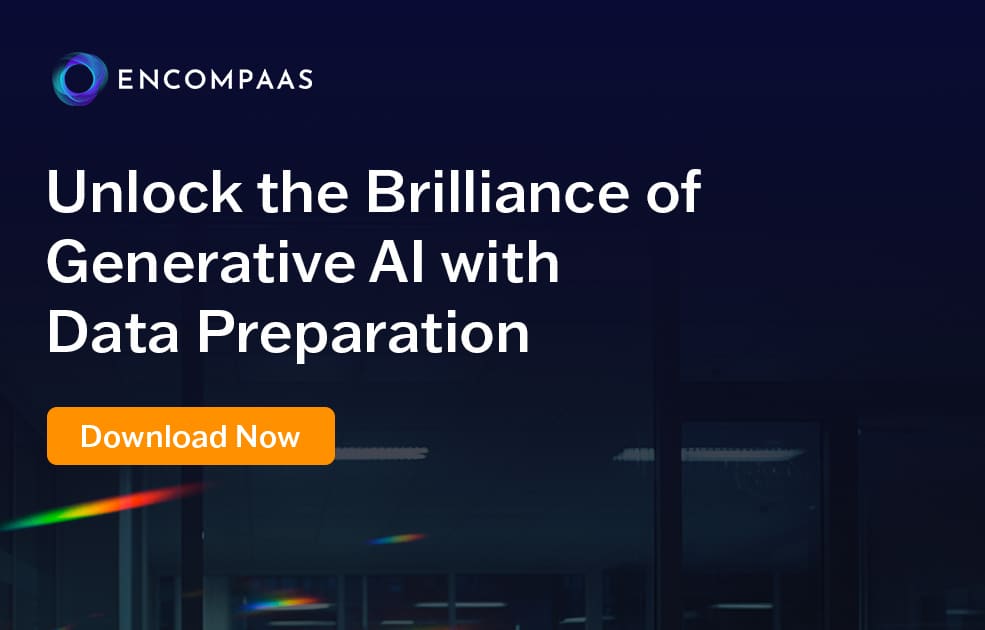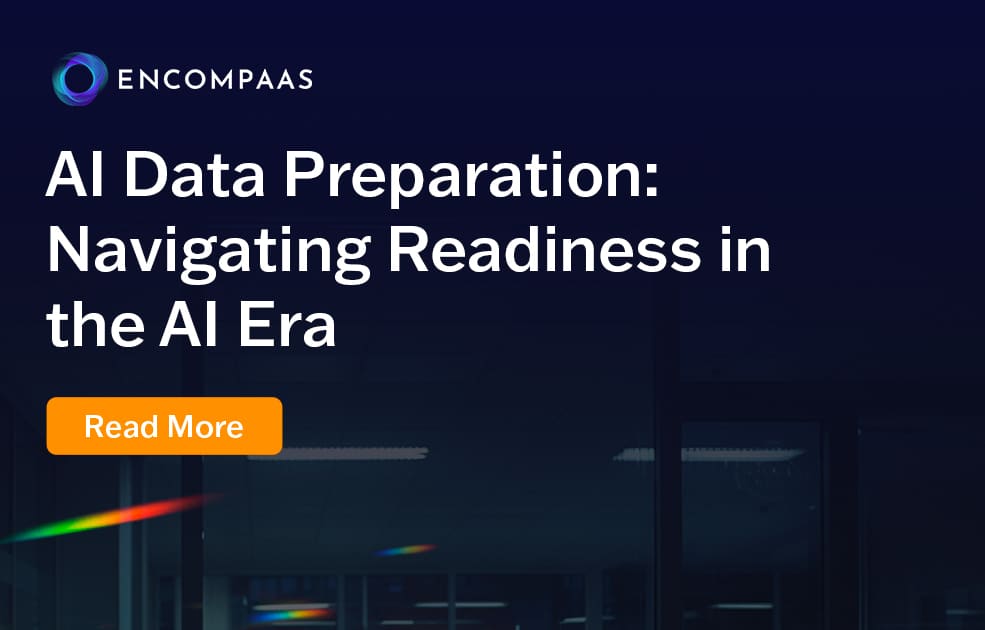What Is Intelligent Document Processing (IDP)? A Quick Guide
Authored by EncompaaS - Mar 22, 2023

Businesses of all sizes grapple with mountains of documents – invoices, contracts, forms, and more. Manually processing this information is time-consuming, error-prone, and hinders efficiency.
Intelligent Document Processing (IDP) offers a solution, automating the extraction and understanding of data from diverse document formats.
This quick guide is your first step into the world of IDP, showing you how it redefines handling paperwork.
Main takeaways from this article:
- Intelligent document processing, or IDP, employs AI technologies like Optical Character Recognition (OCR), Natural Language Processing (NLP), and Machine Learning (ML) to efficiently process and analyze both structured and unstructured data from various documents, significantly enhancing business operations by converting them into actionable insights.
- By automating data extraction and reducing the need for manual data entry, IDP not only speeds up document processing but also minimizes errors, leading to more accurate data analysis and decision-making.
- IDP is versatile and scalable, making it beneficial across multiple sectors such as finance, healthcare, legal, and government by streamlining operations, improving customer service, and facilitating quicker and more precise decision-making.
- The core of IDP lies in advanced technologies like OCR for data digitization, NLP for understanding and categorizing text, ML for continuous improvement in data processing accuracy, and Robotic Process Automation (RPA) for enhancing task execution efficiency.
- Successful IDP deployment involves understanding business needs, evaluating the types of data to be processed, scrutinizing vendor capabilities for scalability, security, and compliance, and ensuring the chosen solution integrates seamlessly with existing systems to maximize efficiency and data integrity.
- Offering an AI-driven IDP solution that excels in processing efficiency and accuracy through OCR, NLP, and ML technologies, EncompaaS seamlessly integrates with existing business systems, setting a new benchmark for document management and enabling companies of all sizes to transform their document processes for improved strategic decision-making.
What is intelligent document processing (IDP)?
Intelligent Document Processing (IDP) is a tech-driven approach that uses artificial intelligence and machine learning to automate the extraction and processing of data from various document types.
It streamlines workflows by accurately identifying, classifying, and converting unstructured data into a structured format, enhancing efficiency, reducing errors, and enabling smarter decision-making in businesses.
The rise of IDP
The rise of Intelligent Document Processing (IDP) marks a significant evolution in how businesses manage data. With the digital era demanding faster, more accurate information handling, IDP emerges as a critical solution. It automates the labor-intensive process of document analysis, transforming unstructured data into actionable insights.
Think of IDP as a combination of artificial intelligence technologies like Optical Character Recognition, Natural Language Processing, and Machine Learning. These technologies work together to identify and extract relevant data from various documents, no matter how complicated they may be, and present it in a format that is easy to understand.
Key benefits of implementing IDP
Let’s delve into what makes IDP a game-changer for organizations and why you should consider implementing it for your business.
1. Enhanced efficiency and productivity
Using IDP technology reduces the need for manual document handling, making processing faster. Automating data extraction and document sorting, which used to be time-consuming tasks, allows for quicker access to important information, increasing productivity in your organization.
2. Improved accuracy and reduced errors
Automating data extraction and processing minimizes the chances of human error, ensuring greater precision. Using IDP systems powered by OCR, NLP, and ML technologies, you can efficiently process documents, enhance accuracy, and significantly reduce instances of miscalculations and mistakes.
3. Scalability
Intelligent document processing allows the processing of vast volumes of documents effectively. Its scalable nature ensures that significant document loads can be handled without demanding additional resources. It’s like a force multiplier for your existing capabilities, automating large-scale data processing and drastically boosting overall productivity.
4. Insightful data analysis
Turning unstructured documents into actionable insights is like mining for gold in a vast landscape. IDP sorts through the chaos, drawing out the golden nuggets of knowledge and arranging them neatly. It converts raw data into understandable reports, facilitating informed decisions. It’s the edge that your business needs.
IDP use cases across industries
Across multiple sectors, IDP is revolutionizing business operations and decision-making processes by unlocking hidden value from vast volumes of documents and delivering enhanced data accessibility.
Finance
In finance, institutions are weighed down by significant volumes of paper documents. For instance, loan processing involves various stages of document handling, from application forms to credit reports. Here, IDP steps in as a lifesaver. It swiftly captures data from these documents, even from unstructured sources, and automates their sorting, classification, and processing. This means banks can process loans faster, improving their customer service.
Healthcare
In healthcare, data accuracy is crucial, as lives depend on it. Hospitals are known for handling extensive paperwork, from patient records to insurance claims forms. IDP can expedite data extraction from these documents and update electronic health records with remarkable accuracy. As a result, healthcare providers can offer more personalized care and expedite claims processing.
Legal
IDP has made it easier for legal professionals to get support in litigation. In the past, lawyers had to spend a lot of time going through case files and court documents. But now, with IDPs automated extraction, classification, and indexing of important information from these documents, lawyers can save a lot of time and concentrate on creating winning strategies instead of being overwhelmed with paperwork.
Government
In government agencies, officials deal with heaps of paperwork. IDP stands as a critical technology here as well. For example, for processing documents like citizen’s benefit claims, IDP can be employed to extract data from a variety of documents and process that in a fraction of the conventional time. This leads to more efficient service delivery, improving citizen satisfaction.
Core technologies behind IDP
If you’ve been wondering, “How does intelligent document processing work?” this section will reveal how. It briefly discusses the innovative technologies that are at the core of IDP and are responsible for its game-changing capabilities.
1. Optical character recognition (OCR)
OCR technology works by scanning images or documents, recognizing the characters present, and converting them into digital text. This process allows the data to become searchable and editable, taking us a step closer to a paperless world.
2. Natural language processing (NLP)
As a key component of IDP, NLP delves deep into the document and tries to understand and make sense of the language. NLP examines the document’s content and puts it into categories based on the meaning and context. This helps to organize the data so that it can be analyzed more easily.
3. Machine learning (ML)
ML algorithms are the brain of IDP systems, enabling them to continually evolve. Through a process known as supervised learning, these algorithms adjust to improve precision by recognizing and learning from previous mistakes. As a result, the accuracy of data extraction enhances over time, making information processing increasingly effective.
4. Robotic process automation (RPA)
Like a reliable office assistant, RPA tirelessly automates routine document tasks, speeding up processing times and freeing up your staff for more substantive work. When integrated with IDP, RPA becomes even smarter, connecting the dots between documents and extracting data with enhanced precision. It’s like switching on autopilot, but with an extra dose of intelligence!
How IDP works: A step-by-step overview
Let’s delve into the nitty-gritty of how IDP operates. We’ll walk through the foundational steps this technology uses to convert unstructured data into insightful information.
1. Document ingestion
First things first, IDP needs its data. This involves:
- Initial capture: Physical documents are automatically scanned, while digital ones are seamlessly uploaded.
- Format recognition: No matter if it’s a PDF, Word doc, or even an image, IDP can easily identify and handle various document formats.
2. Pre-processing
This step involves getting the documents ready for analysis. IDP performs some prepping tasks, such as:
- Image enhancement: This is required toadjust the lighting in a photo so that IDP sharpens blurry images and removes background noise.
- Layout analysis: IDP identifies different sections like text blocks, tables, and even embedded images within the document.
3. Data extraction with OCR
Now comes the key part: turning information into usable data. Here’s how:
- Text recognition: IDP uses Optical Character Recognition (OCR) to convert scanned text into machine-readable format.
- Data verification: Both automated checks and manual reviews are used to check the accuracy of the extracted text.
4. Data interpretation with NLP
Extracting data is one thing; understanding it is another. IDP employs powerful tools for:
- Content categorization: Using Natural Language Processing (NLP), IDP grasps the overall context and classifies the document’s content (e.g., invoice, contract).
- Entity recognition: IDP acts like a super highlighter, pinpointing specific details like names, dates, and amounts.
5. Data enrichment with machine learning (ML)
Here, ML adds another layer of intelligence with:
- Pattern learning: ML algorithms learn from processed data, identifying patterns and potential errors.
- Continuous improvement: As IDP encounters more information, it constantly adapts and refines its processes for even better results.
6. Analysis and integration
The extracted data is valuable, but what can we do with it? IDP makes it usable via:
- Insight generation: IDP analyzes the data to generate reports and uncover trends that can inform business decisions.
- Integration into business processes: The processed data is seamlessly integrated into existing systems like CRM or ERP software, making it readily available for further action.
7. Quality control and compliance
Accuracy and security are paramount, so IDP employs:
- Accuracy checks: Regular checks help ensure the data extracted by IDP is not only usable but reliable.
- Compliance monitoring: IDP ensures data handling adheres to all relevant regulations and internal guidelines.
8. Feedback loop
Just like any good system, IDP thrives on continuous improvement:
- User feedback integration: User corrections and suggestions are incorporated to refine the IDP process.
- System updates: Learnings from data and user feedback are used to constantly update and enhance the IDP system.
How to get started with intelligent document processing software?
When deciding to implement an IDP solution, there are important factors that you should keep in mind to ensure a successful transition. Here are some key considerations:
Identify business requirements
Firstly, you need to identify your business needs. Where are your document management bottlenecks? What kind of data are you handling? Understanding your specific requirements will help you select an IDP solution that best suits your needs.
Determine the data types to process
The type of documents and the nature of the data therein significantly influence the choice of an IDP solution. Whether dealing with structured, semi-structured, or unstructured data, ensure your chosen IDP software can handle your specific needs.
Evaluate vendor capabilities
Look for detailed information about the probable outcomes, productivity improvements, compatibility of the solution with your current systems, and the convenience of user adaptation.
Scalability
Can the system grow with your business? A successful IDP solution should be able to expand and manage an increasing number of documents as your business grows in both size and complexity over time.
Security and Compliance
Given the sensitive nature of document data, security is a priority. Your chosen IDP solution must comply with regulatory guidelines and should guarantee the safety of your data. The right IDP solution safeguards sensitive document data, ensuring integrity and confidentiality at all times.
Transform document processes with EncompaaS
IDP technology has the remarkable ability to revolutionize document management. By turning both unstructured and structured data into actionable insights, IDP not only enhances efficiency but also delivers accurate data analysis, driving strategic business decisions.
To leverage a robust document processing and management platform for your business, EncompaaS provides the perfect, state-of-the-art solution. Offering an innovative IDP platform powered by AI, EncompaaS establishes a new standard for document management processes.
Its approach includes key components such as OCR for meticulous data mining, NLP for interpreting context, and Machine Learning for enhanced data interpretation. Learn more about how EncompaaS can cater to your unique business needs, or simply book a demo to test the platform’s unique capabilities for yourself!
Book a demo
Let's get started
Experience the Power of EncompaaS!
Submit this form to see EncompaaS in action with a demo from our information management experts.
Request a demo today
Related Resources

- video
Understand Your Data & Harness Generative AI
Jesse Todd (CEO, EncompaaS) and Jaimie Tilbrook (CPO, EncompaaS) delve into the critical challenges companies face in managing their vast data landscapes, emphasizing the importance of understanding what data is, where it is located, its context, and its value.
Learn More




